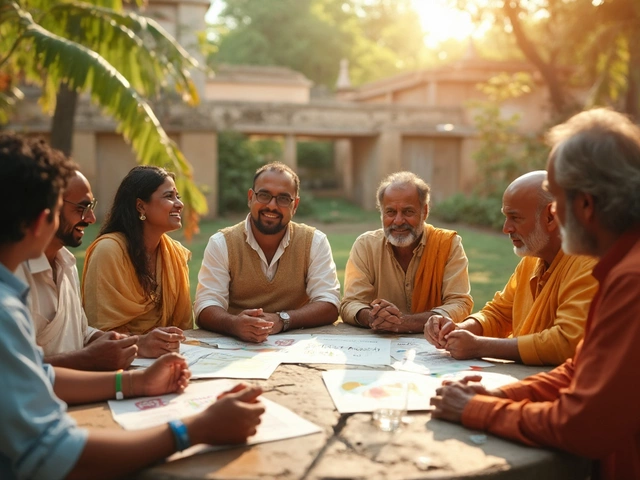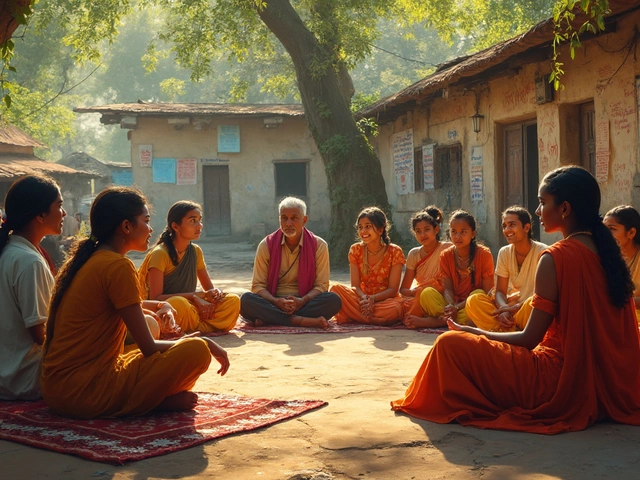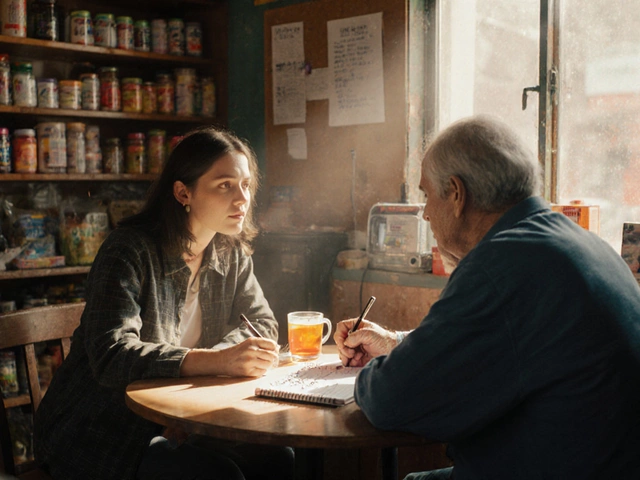Ever notice how some community projects just seem to fizzle out, while others get everyone fired up? It usually comes down to the core values behind the scenes. These are like the unspoken rules that shape how people connect, how problems get solved, and even how arguments get sorted out. Forget corporate jargon—these values decide if people show up and stick around or bail after two meetings.
Getting community engagement right isn’t about having all the answers from day one. It’s about showing up with the right mindset. If you’re trying to make a difference—whether it’s cleaning up a local park or getting new crosswalks for your block—those core values are what keep things moving. And trust me, knowing what they are (and how to actually use them) can turn awkward meetings into real progress.
- Why Core Values Matter in Community Engagement
- Value #1: Inclusiveness—Making Sure Everyone Is Heard
- Value #2: Transparency—Keeping Things Open and Honest
- Value #3: Collaboration—Working Together for Real Results
- Value #4: Respect—Building Trust and Lasting Relationships
Why Core Values Matter in Community Engagement
Core values might sound like business talk, but here, they're the stuff that separates a strong community from a disconnected group of people. When outreach groups stick to a clear set of values, you get trust, teamwork, and actual results instead of frustration and confusion.
Here’s the thing: communities that focus on strong values see better turnout and real involvement. According to a 2023 National Civic League survey, neighborhoods with defined engagement values had participation rates nearly twice as high as those without. It’s not just about showing up. It’s people feeling safe to speak up, knowing their opinions won’t be brushed off or ignored.
Think about what happens when values get ignored. Meetings spiral into arguments, newcomers get left out, and everyone eventually loses interest. But stick to simple shared principles, and suddenly, people feel like part of something bigger. They want to help, not just because they have to, but because they see their input makes a difference.
Let’s break down what really changes when you stick to real values:
- Community engagement goes up—people show up and keep coming back.
- Communication is smoother—folks know the ground rules and what’s expected.
- Trust builds—no one feels like they’re wasting their time.
- You solve problems faster—even when opinions clash, there’s a roadmap for finding common ground.
Here’s a quick look at what happens with and without core values:
| With Core Values | Without Core Values |
|---|---|
| High participation—most voices heard | Poor turnout—few people get involved |
| Clear goals, easier decision making | Messy priorities, arguments go nowhere |
| Long-term commitment | Quick burnout & lost trust |
If you want your team, neighbors, or partners to move from just talking to making real changes, start nailing down and sticking to your values. It doesn’t have to be complicated—but it’s a game changer if you get it right from the start.
Value #1: Inclusiveness—Making Sure Everyone Is Heard
It’s wild how often people are left out of the conversation when it comes to community work. Inclusiveness is more than just sending out invites or sticking posters on a few walls. You want real engagement? You’ve got to make it possible for everybody to show up and be heard—no matter their age, background, or how much they usually talk at meetings. When you genuinely include different voices, creative solutions pop up, and people care a whole lot more about what’s going on.
Let’s get real: communities are never just one group. In the U.S., nearly 22% of the population speaks a language other than English at home, and that number leaps to more than 40% in cities like Los Angeles and Miami. So, if you only hold meetings in English, you’re missing out on a huge slice of your own neighbors. The American Planning Association says,
"Inclusive engagement is about intentionally reaching stakeholders who are often missed, and valuing their input equally in the process."Turns out, that’s a lot harder than just sending a group email.
- Host meetings at different times (evenings, weekends) to hit all work schedules.
- Offer translation or interpretation so language isn’t a barrier.
- Give people the option to join in-person or online.
- Have childcare or snacks to help families participate.
- Keep discussions casual so folks aren’t intimidated.
When people get left out, the whole project suffers. A study out of Harvard tracked over 200 community projects and found that those that scored high in inclusiveness had 45% better long-term results—think more volunteer hours, fewer dropouts, and bigger turnouts at public events.
| How Inclusiveness Impacts Results | Inclusive Projects | Non-Inclusive Projects |
|---|---|---|
| Average Volunteer Hours (per month) | 220 | 122 |
| Event Turnout (percent of invited) | 63% | 30% |
| Project Completion Rate | 84% | 51% |
The real kicker? When people see you’re serious about including everyone, they keep coming back. If your goal for community engagement is to build something that lasts, start by listening to voices you don’t usually hear. That’s how real change gets rolling.

Value #2: Transparency—Keeping Things Open and Honest
Think about the last time you tried to get people involved in something and nobody really knew what was happening behind the scenes. Pretty frustrating, right? That’s why transparency is so important in community engagement. It’s all about making sure everyone knows what’s going on, why things are done a certain way, and who’s making the decisions.
Let’s get real: without transparency, trust breaks down fast. Residents start gossiping or making up their own stories. Suddenly, you’re spending more time putting out fires than actually making progress. There’s real proof behind this. A 2023 survey by the National Coalition for Dialogue & Deliberation found that communities who reported "high transparency from leaders" had 35% greater participation rates than those where things were kept under wraps.
So, how do you keep things open and honest? Here are a few useful tips anyone can follow:
- Share info early and often. Give updates through email, social media, or old-school flyers if needed.
- Be clear about why decisions get made. If one park gets a new playground before another, explain the reason (like safety or budget constraints).
- Invite questions and feedback at every stage. Don’t just make a decision and hope people are okay with it.
- Admit mistakes. Nobody expects perfection. If something goes wrong, own it and explain what’s being done to fix it.
One easy way organizations boost community engagement is to upload meeting notes and financial reports online. Even a simple neighborhood Facebook group can move mountains for transparency. The point is, if people feel like they’re in the loop, they’ll stay involved and keep the group running strong. Transparency isn’t just the right thing to do—it’s the smart move if you want energy and ideas to keep rolling in.
Value #3: Collaboration—Working Together for Real Results
Trying to tackle big community problems alone never works—it’s collaboration that actually makes change happen. When people from different groups bring their skills and ideas to the table, you get more creative solutions and way less burnout. Research from the National Council of Nonprofits shows that successful community projects almost always have some level of cross-group teamwork. It’s not just about group hugs; it’s about getting things done faster and better.
Collaboration starts when you drop the “us versus them” mindset. You need school reps, local business owners, city officials, and regular folks working side by side. Real results come from sharing responsibility, dividing up tasks, and backing each other up when things get tough. If your *core value* isn’t about working together, you’ll end up spinning your wheels.
Here are some easy, practical ways to make collaboration actually work in your community:
- Set up regular check-ins—monthly is a sweet spot so nobody gets overwhelmed.
- Use shared online docs or group chats to keep everyone in the loop.
- Make it clear what everyone’s job is, so tasks don’t fall through the cracks.
- Open the floor for feedback at every stage. The best ideas sometimes come from folks who barely talk in bigger groups.
You know those murals popping up in urban neighborhoods? Most are the result of local artists, business owners, and residents teaming up and pitching in. There’s statistical muscle behind this, too. A 2022 study by the Urban Institute found that community projects involving at least three partner groups reached their goals 40% more often than those flying solo. That’s a big jump.
| Type of Project | Number of Groups Involved | Success Rate (%) |
|---|---|---|
| Solo-led | 1 | 39 |
| Small Team | 2 | 57 |
| Full Collaboration | 3+ | 79 |
Sharing the wins (and the headaches) brings people closer and builds trust. If someone else is better at fundraising or organizing events, let them handle that angle while you do what you do best. That’s the kind of teamwork that keeps people excited and gets real results. Collaboration isn’t just a buzzword—it actually pays off.

Value #4: Respect—Building Trust and Lasting Relationships
Respect sounds basic, but when it’s missing from community engagement, things fall apart fast. You can have the best ideas, slick presentations, and even a bit of money, but if people feel talked down to or ignored, they’ll walk. Simple as that.
Here’s what respect looks like in action: listening without cutting people off, following up with folks who spoke up at a meeting, and remembering that every story or concern matters. The National Civic League, which has decades of studies under its belt, found that communities who actively show respect in meetings see better follow-through and longer-lasting partnerships. That’s not just talk—groups that score high on respect actually finish more projects together.
Respect is especially important when people from different backgrounds, ages, or walks of life are involved. One misstep—like using jargon or brushing off a local concern—can break trust in seconds. But when someone feels heard, they’re way more likely to stay involved, bring their friends next time, and even step up to lead future efforts. That’s how you build a real network instead of a flash-in-the-pan crowd.
- Let people finish what they’re saying before adding your thoughts.
- Follow up on concerns, even if you can’t fix the issue right away—acknowledgment goes a long way.
- Skip the show-off language. Use plain, clear words so everyone is on the same page.
- Admit mistakes fast and explain how you’ll avoid them next time. People respect honesty.
Want your community engagement to last? Focus on small, consistent acts of respect. It’s not about grand gestures but about making people feel valued every time they show up. That’s the stuff that earns trust, gets things done, and keeps your group coming back.





